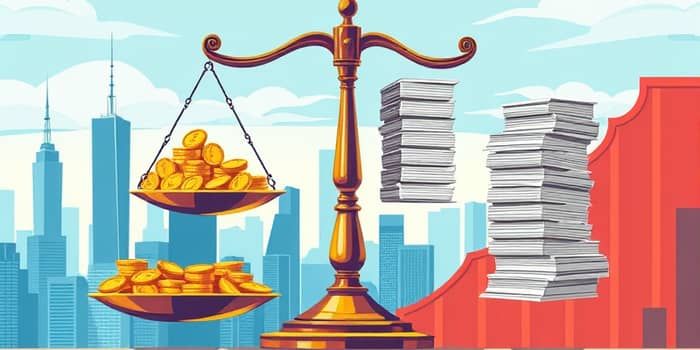
Managing borrowed capital wisely can make the difference between long-term growth and devastating financial setbacks. While leverage offers opportunities to expand investments beyond one’s personal resources, unchecked borrowing risks wiping out equity in a market downturn. Understanding the fine balance between risk and reward is essential for any investor or business leader aiming to preserve hard-earned capital in downturns without sacrificing strategic growth potential.
Recent surveys show that hedge funds often employ average leverage ratios between 2x and 5x, with extremes exceeding 10x. While this can generate outsized returns in calm markets, the rapid market swings of 2020 erased significant value in a matter of days, underlining why prudent limits are non-negotiable for capital preservation.
At its core, leverage involves using debt to enhance investment returns. By committing borrowed funds alongside personal equity, investors can amplify gains—but also magnify losses. There are two principal forms of leverage:
A tangible example illustrates the multiplier effect: by investing $10,000 of personal funds and borrowing $90,000, an investor controls a $100,000 asset. A 10% increase in market value yields a $10,000 profit, effectively doubling the investor’s equity. Conversely, a 10% decline wipes out the entire $10,000, demonstrating how powerful growth and significant risk can unfold with the same strategy.
Beyond simple percentage changes, leverage interacts with interest rates, repayment schedules, and collateral requirements. Even small rate hikes can increase debt servicing costs substantially, reducing net returns or forcing asset sales under pressure. As such, mastering the mechanics requires vigilance and foresight.
When deployed with care, leverage produces substantial upside through amplified returns and devastating losses, depending on market conditions. The primary benefits include:
However, these advantages come with clear trade-offs. Firms with high leverage ratios must maintain robust cash flows to service interest and principal obligations. During economic contractions, revenues may fall even as debt payments remain fixed, creating a liquidity crunch. In worst-case scenarios, creditors may demand collateral or accelerate loan maturities, potentially triggering a cascade of distress measures.
Financial institutions regularly assess their risk exposure by stress testing portfolios under various scenarios. Individual investors can adopt a similar mindset by evaluating the impact of hypothetical price declines, interest rate shifts, and changes in income streams. This disciplined approach ensures that leverage remains a tool for growth rather than a pathway to ruin.
History provides stark illustrations of both triumph and collapse under leverage. Corporations like Apple and Microsoft have harnessed debt markets to execute share buybacks and strategic acquisitions without depleting cash reserves. Apple’s 2013 bond issuance raised $17 billion, funding dividends and buybacks while preserving over $150 billion in cash for future innovation. Microsoft financed its acquisition of LinkedIn with a $26.2 billion bond offering, demonstrating that preserve hard-earned capital in downturns can coexist with aggressive growth.
Berkshire Hathaway’s use of insurance float—premiums collected before claims are paid—serves as an unusual form of leverage. By investing those float funds into stocks, bonds, and acquisitions, Berkshire has generated outsized returns while maintaining conservative underwriting standards.
On the other end of the spectrum, Toys “R” Us and Sears Holdings overleveraged during private equity buyouts, loading their balance sheets with debt that became unserviceable amid declining retail traffic. Both companies filed for bankruptcy within months, closing hundreds of stores and erasing investor equity. The 2007–2008 subprime mortgage crisis further highlighted the perils: financial institutions with leverage ratios above 30:1 saw asset values fall by 20–30%, wiping out mandates and leading to government bailouts. These cautionary tales underscore why avoid catastrophic financial consequences in markets demands strict leverage limits.
During the subprime crisis, several investment banks reported leverage ratios above 30:1, meaning a mere 3% drop in asset values could wipe out equity. Firms like Lehman Brothers and Bear Stearns ultimately collapsed under such extreme structures, illustrating that ensure steady long-term wealth accumulation demands leverage discipline.
Quantitative measures allow investors to gauge leverage responsibly and protect against unpredictable market swings. Common ratios include:
While industry benchmarks vary, staying within conservative ranges—for example, a debt-to-equity ratio below 1.0 and interest coverage above 3—can signal sustainable leverage levels. Monitoring these metrics over time enables timely adjustments before risks escalate.
Capping leverage exposure allows investors and businesses to navigate downturns without sacrificing long-term objectives. Effective techniques include:
Another critical tactic involves laddering debt maturities so that obligations are spread over time rather than concentrated in a single period. This approach prevents refinancing risks and reduces vulnerability to sudden credit market freezes. Setting internal leverage caps—based on both absolute debt limits and leverage ratios—fosters discipline and avoids emotional decision-making in frothy markets.
Psychological biases can lead borrowers to underestimate downside risks during prolonged bull markets. The allure of easy credit often breeds overconfidence, driving stakeholders to chase increasingly aggressive leverage targets. Incorporating mandatory review processes, such as risk committee approvals and scenario analyses, helps counteract these tendencies.
Regulatory agencies also play a vital role in maintaining systemic stability. Banks and public companies face leverage thresholds to prevent contagion risks. For instance, U.S. bank regulators impose a Supplementary Leverage Ratio requirement, mandating that Tier 1 capital equals at least 3% of total leverage exposure. Aligning corporate policies with such standards not only safeguards solvency but also enhances market credibility.
Cognitive traps such as the gambler’s fallacy and anchoring bias can further skew leverage decisions. When markets rally, many investors assume conditions will persist indefinitely, leading them to layer more debt precisely at peaks. Others, driven by loss aversion, may increase leverage to chase quick recoveries, inadvertently compounding risk. Awareness of these behaviors is crucial to maintain disciplined leverage management practices and avoid emotional pitfalls.
Leverage remains a potent catalyst for growth, enabling organizations and individuals to pursue opportunities beyond their immediate capital. Yet without vigilant constraint, it becomes a dangerous double-edged financial weapon that can amputate equity and imperil futures. By understanding leverage mechanics, monitoring key ratios, and implementing robust risk controls, stakeholders can harness borrowed funds responsibly.
Ultimately, the objective is clear: through thoughtful limits and strategic oversight, you ensure that leverage fuels opportunity rather than destruction, paving the way for sustainable, long-term prosperity.
References













